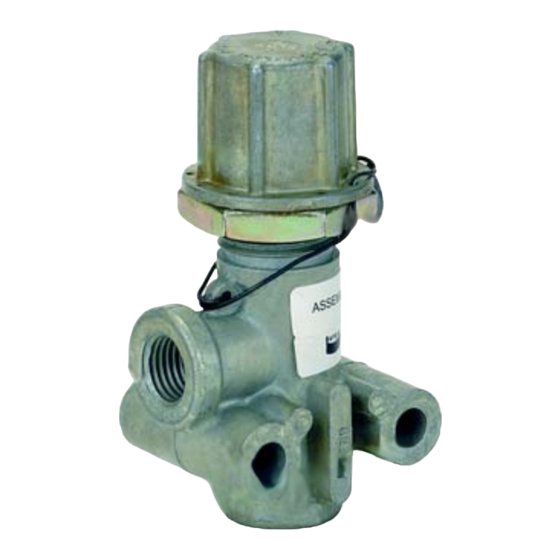BENDIX RV-1 PRESSURE REDUCING VALVE Manuale
Sfoglia online o scarica il pdf Manuale per Unità di controllo BENDIX RV-1 PRESSURE REDUCING VALVE. BENDIX RV-1 PRESSURE REDUCING VALVE 4. Pressure reducing valve

®
™
Bendix
RV-1
ADJUSTING CAP
DELIVERY
PORT
MOUNTING
HOLES
DESCRIPTION
™
The RV-1
pressure reducing valve is used to reduce air
pressure and maintain it at a constant specified pre-set
pressure below that of the supply pressure. The pressure
reducing valve has a 1/4" delivery port on the side and a 1/4"
supply port on the bottom. Two 9/32" mounting holes are
cast into the body. A lockwire and seal are optional for a
tamper proof setting.
OPERATION
The pressure setting of the pressure reducing valve is
determined by the setting of the adjusting cap, which exerts
a force on the spring on top of the piston. Compressed air
enters the supply port and passes out the delivery port.
When the air pressure on the bottom of the piston overcomes
the force of the spring on top of the piston, the piston moves
upward and the inlet valve spring forces the inlet valve on its
seat, closing off the supply of air. As the pressure in the
delivery line drops, the force of the spring above the piston
becomes greater than the air pressure below the piston,
allowing the piston to move downward, moving the inlet valve
off its seat and allowing air to pass out the delivery port.
If pressure in the delivery line exceeds the pressure setting
of the pressure reducing valve, the force exerted by the air
pressure below the piston will be greater than the spring
force above the piston. The piston will move up from the
exhaust valve, permitting air to pass by the exhaust valve,
Pressure Reducing Valve
LOCK WIRE
SUPPLY
PORT
PRESSURE
REGULATING
EXHAUST
PISTON
& SEAL
O-RING
INLET &
EXHAUST
VALVE
through the hollow piston and valve guide and escape through
the slot in the adjusting cap. When the force of the spring
above the piston overcomes that of the air pressure below
the piston, the exhaust valve is seated, and the pressure in
the delivery line is the same as the setting of the pressure
reducing valve.
Note: The RV-1
applications where the supply and delivery pressure is stable
and constant. A rapid or pulsed supply and/or delivery
pressure is not recommended. Please consult Bendix
Engineering with specific application requirements.
OPERATING AND LEAKAGE TESTS
Connect a 120 psi pressure source to the supply port and
connect an accurate test gauge to the delivery. Observe the
gauge with the supply pressure applied, this is the delivery
pressure (the inlet valve is closed). If the pressure delivered
is more than ±5 psi from the pressure indicated on the tag
attached to the valve or vehicle manual, the valve can be
readjusted. Momentarily bleed off some of the delivery
pressure. Discontinue bleed off and recheck the delivery
pressure. The delivery pressure should again be within ±5
psi of the pressure indicated on the tag.
Check for leakage at the adjustment cap base with soap
solution. Leakage should not exceed 100 SCCM or a 1"
bubble in 5 or less seconds. Excessive leakage may indicate
a leaking piston o-ring or inlet/exhaust valve.
SPRING
VENT
™
valve should be used in light duty
CAP
LOCK
NUT
PISTON
VALVE GUIDE
WIRE
INLET VALVE
SPRING
1
